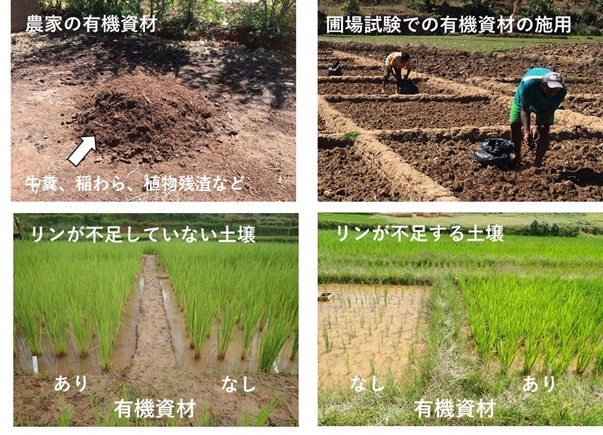Pick Up
335. Using Organic Materials to Overcome Low Productivity of Rice Cultivation in Madagascar

More than 10 soil nutrients, including nitrogen and phosphorus, are required for the growth of crops, and it is necessary to keep replenishing the nutrients used for each harvest.
In particular, phosphorus is an essential element for all living things, and it is said that the amount of phosphorus present on the earth determines the limit of biomass of the global ecosystem. On the other hand, it is difficult for humans to intervene in the phosphorus circulation system, and it is believed that phosphorus circulates in the natural world through its own unique mechanism. If we think of plants as the starting point, the plant dies or the animal that ate the plant dies, then microorganisms decompose the plant, return it to the soil, and is then absorbed again by the roots of the plant. This cycle can take up to 10 years if it is not done by slash-and-burn methods. On the other hand, the phosphorus that is discharged into the ocean by rain and wind is deposited on the sea floor and reappears on the earth's surface as phosphorus deposits over a million years due to plate tectonics. However, phosphorus deposits are distributed in limited areas around the world.
There are two basic ways to supply phosphorus for agriculture: digging up phosphorus deposits and transporting them as chemical fertilizer, or circulating animal and plant carcasses and manure for a short period of time. The high input agriculture that has developed since the 20th century, with its excessive use of chemical fertilizers, has caused the phosphorus cycle to drastically deviate from the geological process, resulting in environmental pollution and exceeding the planetary boundaries. On the other hand, the small-scale agricultural sector in developing countries cannot afford to supplement phosphorus as a chemical fertilizer, resulting in soil thinning and chronic low production.
Rice is the most important crop in Madagascar, an island nation in Africa. About 85% of the farmers are engaged in rice cultivation, and the per capita rice consumption is much higher than in Japan, with 100 kg of rice consumed per year (Japan's per capita rice consumption is 53 kg per year). However, the country cannot meet all of its rice demand through its own production, and is forced to rely on imports for about 10% of its rice. This is due to the fact that rice yields have been stagnant at a low level for a long time.
The central highlands, which account for half of the country's rice production area, have nutrient-poor soils, as is the case in other parts of Africa. Among the problems is the lack of phosphorus. Even if phosphorus is present in the soil, it is strongly adsorbed by iron and aluminum in a form that cannot be absorbed by the rice plant body, which is a factor in low yields (Nishigaki et al. 2018). Technically, it is possible to increase yield by applying large amounts of chemical fertilizers containing phosphorus. However, for subsistence farmers in Africa, including those in Madagascar, relying on chemical fertilizers to grow rice is a heavy economic burden.
In rural areas of Madagascar, "organic materials" made from local livestock dung and plant residues are more commonly used than chemical fertilizers, which are expensive and difficult to obtain (Tsujimoto et al. 2019). We are developing fertilizer management techniques to effectively use organic materials that farmers can use as an alternative to chemical fertilizers. In the 2021 research article “Farmyard manure application increases spikelet fertility and grain yield of lowland rice on phosphorus-deficient and cool-climate conditions in Madagascar highlands” published in Plant Production Science, the results of demonstration tests in various farmers' fields with different growing environments showed that the application of organic materials preferentially to phosphorus-deficient soils can effectively improve rice productivity (see figure below). In high altitude areas, phosphorus deficiency causes low temperature damage as well as growth retardation, but the application of organic materials can mitigate the risk of low temperature. Radioisotope experiments have shown that the application of organic materials to paddy fields accelerates the solubilization of phosphorus adsorbed in the soil (Tovo & Tsujimoto, 2020), suggesting that these organic materials may be responsible for yield improvement in tropical phosphorus-deficient soils.
These results will contribute to the stable production of rice in oligotrophic soils in Africa, including Madagascar, by making effective use of locally available organic materials instead of relying on chemical fertilizer imports.
This research was conducted under the Science and Technology Research Partnership for Sustainable Development (SATREPS) project “Breakthrough in Nutrient Use Efficiency for Rice by Genetic Improvement and Fertility Sensing Techniques in Africa” (Principal Investigator: Dr. TSUJIMOTO Yasuhiro, JIRCAS)
References
- Breakthrough in Nutrient Use Efficiency for Rice by Genetic Improvement and Fertility Sensing Techniques in Africa(https://www.jircas.go.jp/en/satreps)
- Asai et al. (2021) Farmyard manure application increases spikelet fertility and grain yield of lowland rice on phosphorus-deficient and cool-climate conditions in Madagascar highland. Plant Production Science (in press)
- (https://doi.org/10.1080/1343943X.2021.1908150)
- Nishigaki et al. (2019) Phosphorus uptake of rice plants is affected by phosphorus forms and physicochemical properties of tropical weathered soils. Plant Soil 435: 27-38. (https://doi.org/10.1007/s11104-018-3869-1)
- Tovo&Tsujimoto (2020) Pronounced effect of farmyard manure application on P availability to rice for paddy soils with low total C and low pH in the central highlands of Madagascar. Plant Production Science 23: 314-321. (https://doi.org/10.1080/1343943X.2020.1740601)
- Tsujimoto et al. (2019) Challenges and opportunities for improving N use efficiency for rice production in sub-Saharan Africa. Plant Production Science 22: 413-427. (https://doi.org/10.1080/1343943X.2019.1617638)
Contributor: ASAI Hidetoshi (Crop, Livestock and Environment Division)

